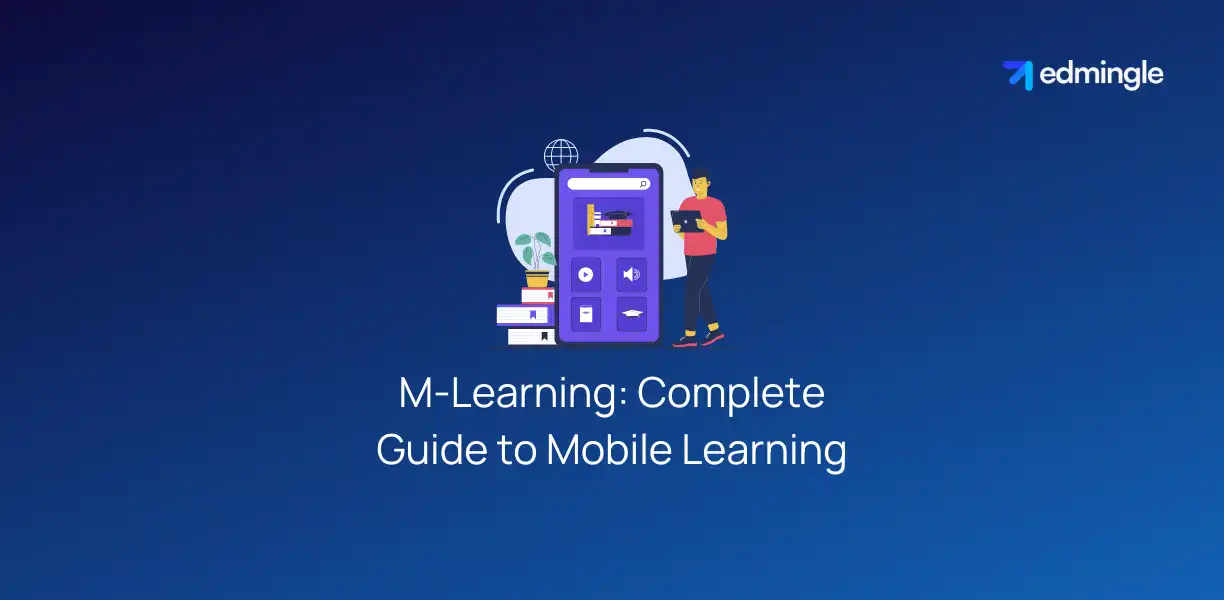
In a world where 80% of the population use mobile phones. It’s no surprise that education has taken a leap into the palm of our hands.
In this era of mobile learning, or m-learning (as it’s trending these days). Education meets convenience, accessibility and innovation.
Studies have shown that an average smartphone user checks their mobile device 221 times & touches it over 2,000 times every single day. This makes it very important to consider putting in your L&D strategy.
In this blog, we’ll delve deep to know how this is transforming the way we absorb knowledge. While breaking down barriers and unlocking endless possibilities for learners.
What is M-Learning?
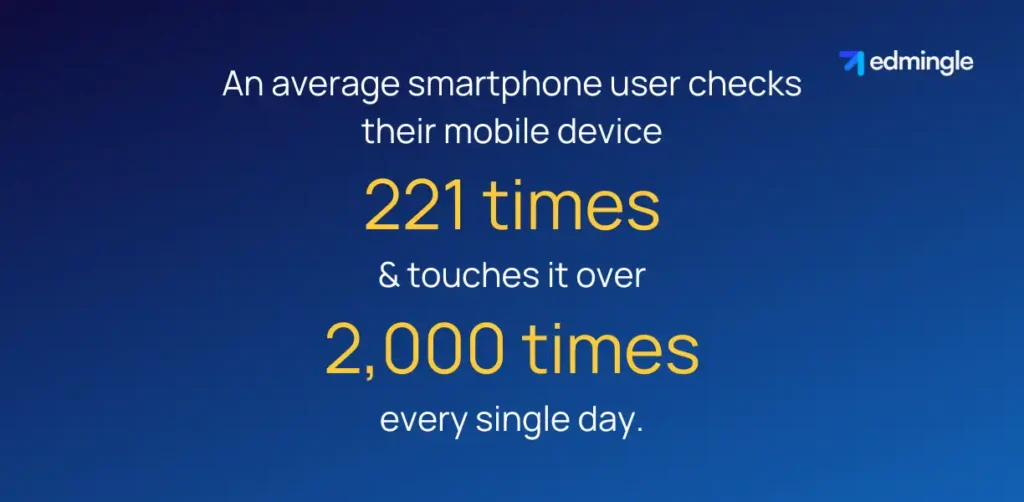
It refers to the use of mobile devices to access educational content. In the process, enabling mobile learners to gain knowledge and skills on the go.
It encompasses a range of digital formats, from e-books & online courses to interactive mobile learning apps. All designed to offer flexible opportunities outside the traditional classroom setting.
From the perspective of an edtech or skill development company, this is a big opportunity. Since business leaders have reported a 55% improvement post implementation.
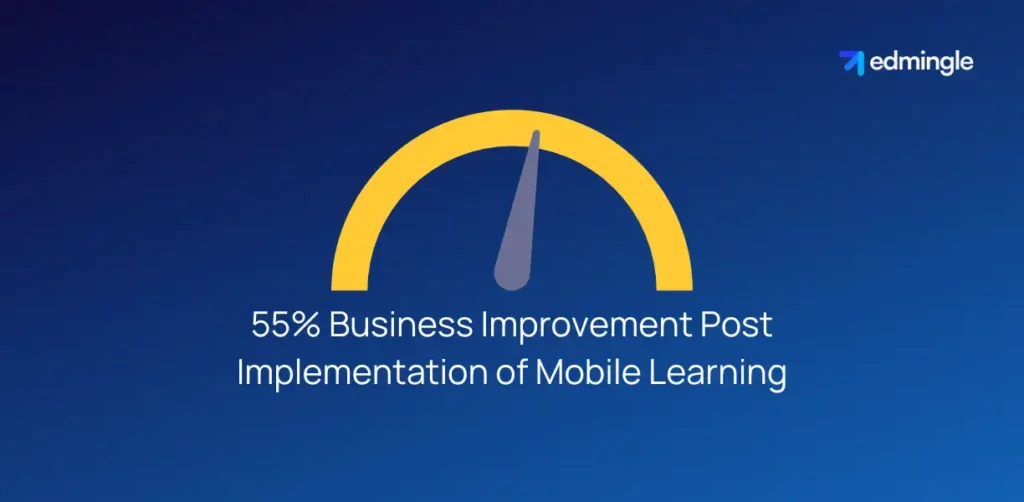
Read about the difference between learning and training.
History
The concept has evolved alongside technological advancements in mobile devices.
With the advent of smartphones & tablets, coupled with widespread internet access. It has transformed learning experiences for users worldwide.
4 Key Characteristics of M-Learning
- Accessibility: It allows learners to access educational materials at anytime and from anywhere. Hence, breaking down both; geographical and time barriers.
- Flexibility: It supports personalized learning paths & lets learners control their pace and style.
- Interactivity: Many mobile applications incorporate interactive elements to enhance engagement & knowledge retention. This includes quizzes, games and more.
- Collaboration: With LMS features like discussion forums & group projects, it facilitates peer-to-peer interaction. Alongside providing collaborative experiences.
4 Major Use Cases
There are many use cases to which this new form of learning can be applied. But we’re highlighting the 4 most-talked about ones.
| Corporate Training: Companies implement it for on-the-job training and skill/professional development. | Language Teaching: Mobile apps have become popular tools for teaching new languages. Majorly by offering bite-sized lessons and practice exercises. Also read about LMS for language teaching. |
| Higher Education: Educational institutions like universities and colleges offer courses and supplementary learning materials via mobile platforms. Hence, supporting blended learning environments. | K-12 Education: Teachers use it to provide engaging educational content. Along with personalized learning experiences for younger students. Also read about LMS for K-12 Education. |
Since we talked about bite-sized lessons. Consider reading our article on integrating micro-learning in your LMS.
3 Most Popular Examples
- Duolingo: A language app that offers lessons in multiple languages. Through gamification and interactive exercises.
- Coursera: An online platform that provides mobile access to courses. From universities and colleges around the world.
- Khan Academy: Offers a wide range of free educational videos and exercises on various subjects. Accessible through its mobile app.
Future of M-Learning
The future of mobile training is set for continued growth and innovation. Emerging technologies like AR and VR are beginning to be integrated into mobile learning platforms.
With the aim to offer immersive and experiential education opportunities. Furthermore, advances in AI will further personalize it. Making them more adaptive to individual learner needs.
As mobile technology continues to evolve, so too will the ways in which we learn. Ultimately, facilitating accessible, engaging and effective learning for everyone.
Also read about what is e-learning.
8 Key Benefits of Mobile Learning
Catering to the evolving needs of learners in the digital age. This trending mode provides the following 8 key benefits:
| 1.Flexibility and Convenience: It allows learners to access educational content from anywhere, at any time. Thereby, making it easier to fit into busy schedules. | 2.Personalized Learning Experiences: Mobile platforms often support personalized learning paths. Enabling learners to progress at their own pace and focus on areas that interest them. |
| 3.Increased Engagement: With interactive content, gamification and multimedia elements. It can make the learning process more engaging and enjoyable. Thus, leading to better retention rates. | 4.Instant Access to Resources: Learners have immediate access to a wide range of resources. Including e-books, videos, podcasts and interactive simulations. |
| 5.Supports Collaboration: Many mobile learning applications include social learning features. These facilitate communication and collaboration among peers and instructors. While enriching the experience through shared insights and discussions. | 6.Cost-Effectiveness: It can reduce the costs associated with traditional training methods. Such as physical textbooks, classroom space, and travel expenses. Hence making education more accessible to a wider audience. |
| 7.Continuous Learning: The ease of access supports continuous, lifelong training outside of formal educational settings. By encouraging individuals to constantly develop their skills and knowledge. | 8.Data Tracking and Feedback: M-learning platforms often include analytics features. These track progress and performance, providing learners with instant feedback. Allowing for adjustments to their strategies. |
These highlight how it meets the demands of the modern educational landscape.
As we talked about cost-effectiveness as one of the key benefits. You might like our article on how Edmingle helps reduce your operational cost by 20%.
7 Potential Limitations of Mobile Learning

Despite its advantages, like any other technology, it also faces several potential limitations. These could impact its effectiveness but upon proper implementation, will cease to exist.
Some of the potential limitations are:
1.Screen Size & Content Adaptation: The smaller screen sizes of mobile devices can hinder the reading experience. Especially for detailed educational content. This may lead to a more challenging navigation.
2.Distractions: Mobile devices are hubs for numerous distractions which can deter the learner’s focus. This includes social media, SMS and other notifications.
3.Technological & Connectivity Issues: Not everyone has access to the latest mobile devices or consistent internet connections. Which can limit their ability to engage with mobile learning content.
4.Data Privacy & Security: Mobile applications & devices collect and store vast amounts of personal and educational data. This can pose potential risks if not properly managed.
5.Assessments: While it is effective for delivering content. Assessing knowledge through mobile platforms can be challenging.
6.Equity and Accessibility: There remains a digital divide when it comes to e-learning accessibility. Which can create inequalities among different socioeconomic groups or learners with disabilities.
7.Over-reliance on Tech: It’s a potential threat to the value of face-to-face interactions and hands-on experiences. Both of which are crucial for comprehensive education.
Addressing these limitations requires a thoughtful design and implementation. Only then is it ensured that it complements traditional educational methods.
Related Article-
Perfect LMS Strategy for E-Learning: Striking the Right Balance Between Screen Time and Hands-On
8 Major Models of Mobile Learning
Even though the term is commonly known by the masses. Very few know that there are several models of mobile learning working in the backend.
These provide insights into how mobile technologies can be integrated into educational contexts. And in the process, often reflect the educational approaches & the tech capabilities of mobile devices.
Major models include:
| 1.Behaviorist Model: This focuses on using mobile devices for drill-and-practice learning activities, quizzes and flashcards. It’s based on the principle that “learning is a change in observable behavior due to external stimuli”. | 2.Constructivist Model: This emphasizes exploration and problem-solving. Learners construct new knowledge by interacting with their environment. And then reflecting on those experiences. |
| 3.Situated Model: This model supports learning in real-life contexts and situations. By making use of the environment to provide relevant, authentic learning experiences. | 4.Collaborative Model: Focuses on social learning, promotes interaction and collaboration among learners. Mobile devices enable learners to communicate, share resources and work together on projects. Regardless of their physical location. |
| 5.Informal & Lifelong Model: Recognizes that learning occurs throughout a person’s life. Digital devices support informal training by facilitating any time learning from anywhere. | 6.Game-Based Model: Utilizes the engaging and motivational aspects of games. By incorporating game-like elements; challenges, levels and rewards. |
| 7.Personalized Model: Tailors the educational experience to the needs, preferences and pace of the learner. Adapts content & suggests resources based on the learner’s progress and feedback. | 8.Augmented Reality Model: Uses AR technology to overlay digital information onto the real world. Hence, enriching the environment with interactive and immersive experiences. |
Each of these models represents a different approach. However, the choice of model often depends on the educational goals, learner needs and the context.
Top 6 Mobile Learning LMS Platforms
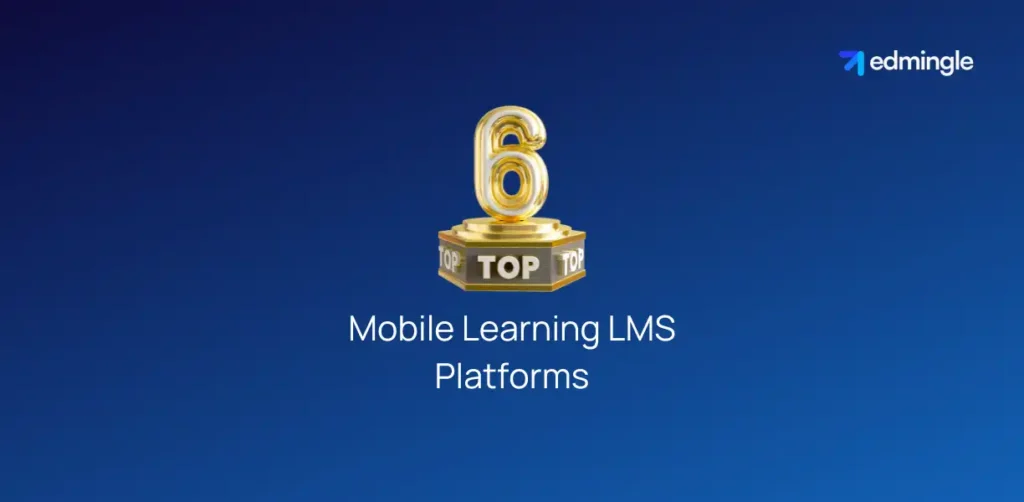
When complemented by LMS platforms, it becomes far more robust in delivering engaging mobile learning experiences. Here are the top 6 platforms that are transforming how we learn and teach.
1.Edmingle
Edmingle is a comprehensive & fast-growing SaaS LMS platform. Known for its user-friendly interface, wide range of features & integrations, it’s ranked in the top 4 LMS in India by Capterra.
It has standout features like multi batch & branch management, 100% white-labelling & exceptional support. To know more about it and explore the platform firsthand;
2.EdApp
EdApp is a leader in microlearning. Delivering bite-sized lessons that are perfect for on-the-go education. Its strength lies in gamification, interactive content & a feature-rich authoring tool.
3.iSpring Suite
iSpring Suite is renowned for its versatility and ease of use. It offers powerful tools for creating interactive courses that are mobile-friendly.
4.Adobe Captivate
Adobe Captivate sets the standard with its advanced interactive & immersive features. It is well-regarded for its capabilities in creating VR training experiences & responsive design.
5.ProProfs LMS
ProProfs LMS is known for its simplicity and effectiveness. It provides a wide array of pre-built templates and quizzes that make course creation quick and easy.
6.UpsideLMS
UpsideLMS is a feature-rich, cloud-based LMS. It offers a blend of traditional and mobile learning environments with its user-centric design.
Each of these platforms brings unique strengths to the table. While catering to various educational needs and styles.
How to Select the Best LMS for Mobile Learning?
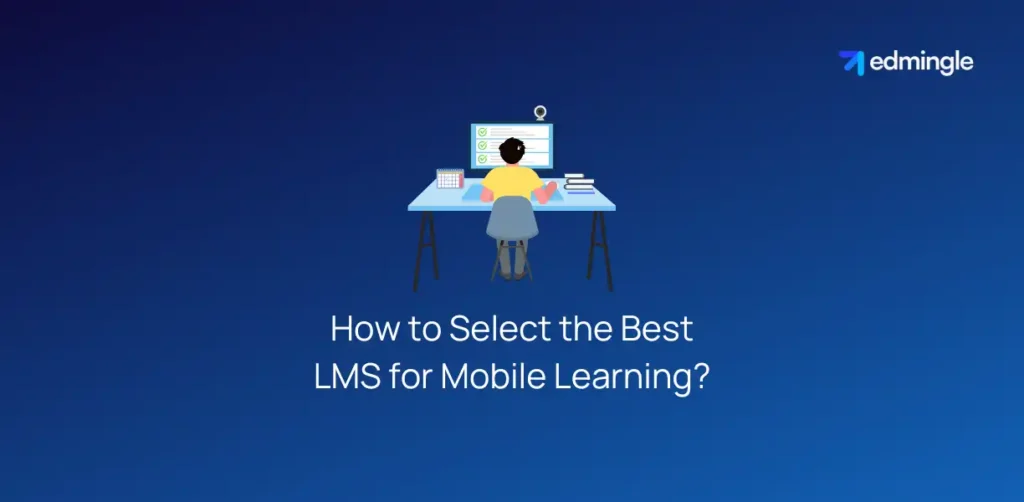
Selecting the best LMS involves considering several key factors. In order to keep the potential limitations at bay and fully tap into the benefits it offers.
Here’s a concise guide to help you make an informed decision:
- Mobile Compatibility: Ensure the LMS offers a responsive design that adapts to various screen sizes and orientations. Providing an optimal learning experience across all portable devices.
- User Experience (UX): Look for an intuitive and user-friendly interface that facilitates easy navigation and access.
- Content Adaptability: Choose an LMS that supports a wide range of training content types & allows for easy content creation and customization.
- Engagement Features: Consider platforms that incorporate engagement tools. Such as gamification, interactive quizzes and collaboration features to maintain learner motivation.
- Offline Access: An LMS that offers the ability to download relevant content for offline viewing is crucial. Especially for learners who may not always have reliable internet access.
- Assessment and Tracking: Evaluate the platform’s capabilities for tracking learner progress & providing real-time feedback. While assessing performance through quizzes, tests and analytics.
- Integration and Scalability: The LMS should integrate smoothly with other tools and systems. Alongside scaling to accommodate growing numbers of users & content.
- Security and Privacy: Ensure the platform complies with data protection regulations & offers robust LMS security features.
- Support and Training: Look for providers that offer comprehensive customer support and service. Along with training materials to facilitate a smooth implementation and ongoing use.
By carefully assessing these aspects in relation to your specific needs, budget and goals. You can select the best LMS for mobile education. One that will enhance the overall learner experience and achieve your desired outcomes.
How to Implement a Mobile Learning Program?
Implementing an m-learning program involves strategic planning and execution. To ensure it meets educational goals and engages learners effectively. Here’s a brief step-by-step guide to roll out a successful program:
| 1.Define Your Objectives & Understand Your Audience | 2.Choose the Right Technology | 3.Develop Mobile-Friendly Content |
| 4.Pilot Test with a Small Group of Users for Usability | 6.Implement a Feedback Loop | 7.Evaluate & Adapt |
Implementation requires careful planning with a focus on learner engagement & content relevance. By following these steps, you can effectively create & launch one.
Conclusion
As we wrap up our journey. It’s clear that smartphones & tablet computers have revolutionized not just how we communicate, but also how we learn.
Reflecting on the insights shared in this blog, we realize that mobile learning has indeed taken a firm hold in the educational landscape. And its evident that this mode is not just a fleeting trend but a fundamental shift.
M-learning doesn’t replace traditional classroom training but complements it. And in the near future, it’s set to forge new paths for making education accessible, engaging and effective.
Frequently Asked Questions
1.Is M-Learning Different from E-Learning?
Yes, though both are under the umbrella of digital learning, both are different. E-learning typically refers to training through personal devices like computers or laptops. Often accessed via web browsers and focused on a broader, more stationary environment.
2.What types of content are suitable for M-Learning?
M-learning content ranges from text, images, and videos to interactive quizzes and games. It’s ideally bite-sized or modular to be consumed in short periods.
3.Can M-Learning be used for all subjects and levels of education?
Yes, it can be adapted for various subjects and educational levels. The key is to design content and choose technologies that are appropriate for the subject matter and the learners’ age and skill level.

Leave a Reply